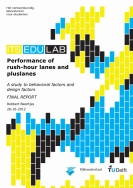Rush-hour lanes and pluslanes have been operational in the Netherlands since 1996. They are intended to increase capacity without the need to add an extra lane to the cross-section. Individually, rush-hour lanes and pluslanes have been evaluated. However, not much research compares designs for rush-hour lane and pluslane with each other. In this research, long-term data will be used to get detailed information about the performance of different rush-hour lane and pluslane designs. Also, a driving simulator study is performed to gain insight in the underlying behavioral factors and to analyze the performance of changes in rush-hour lane designs. The main question for the research is: What is the performance of rush-hour lanes and pluslanes, what are the behavioral factors and design factors causing differences in performance and what changes can be made to the design of rush-hour lanes to improve the performance?
In the ex-post evaluation of performance, data is used for a period of 120 days of 5 highway sections with a rush-hour lane and 5 highway sections with a pluslane. The sections are compared using lane flow distributions that show the occupation of the lanes and intensity-speed relations that show the differences in free-flow speeds driven on the sections. In the first analysis, rush-hour lanes are compared with regular right lanes and pluslanes are compared with regular left lanes. Also, a comparison is made between the occupation of different locations at rush-hour lanes and pluslanes. For this purpose, the start section and the end section are compared with a turbulence-free section. As a final analysis, the design factors that are researched for their influence on performance are: the lane width, the speed limit and the total number of lanes. A lot of variation in these design factors can be found on the rush-hour lane and pluslane sections that have been implemented today. However, some designs have not been implemented yet. The driving simulator provided the perfect opportunity to test new designs of rush-hour lanes. The simulator is used to test the influence of reducing the signaling by 50% and the influence of changing the markings from continuous to broken on the occupation of rush-hour lanes.
Regarding the design factors, it can be concluded from this research that a high speed limit of 120 km/h has a negative effect on the occupation of rush-hour lanes and also on the speeds driven at rush-hour lane sections. The car-following behavior of vehicles on a rush-hour lane section with such speed limit is researched in the driving simulator study. It shows that the incentive of using the rush-hour lane at this speed limit is low. Changing the markings from continuous to broken in the driving simulator does not affect the occupation of the rush-hour lane at 120 km/h. Also, reducing the signaling by half does not affect the occupation. Further research needs to show if these design factors have an influence on the occupation of rush-hour lanes at lower speed limits. Smaller lane widths appear to have a negative effect on the occupation of rush-hour lanes and on the speeds driven at rush-hour lane sections. At pluslane sections with a combination between a high speed limit (100 km/h) and a small lane width (< 2,80 m) the occupation of the pluslane becomes significantly less. Adding an extra lane to the section (making it 3+1) lowers the intensity shares at low intensity levels for that section for both rush-hour lanes and pluslanes. At higher intensity levels, no significant differences were found.
Quantifying the influence of the design factors on the performance of rush-hour lanes and pluslanes is an interesting subject for further research. The performance of managed lanes to be implemented in the future can then be predicted by a model before realization. The differences between start sections and end sections also need to be analyzed in more detail for this purpose. The combination between an ex-post evaluation and a driving simulator study as is used in this research can also be well-suited for that new research.
